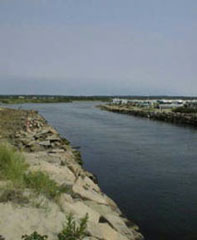| East Beach ~ Barrier Beach |
Physical Characteristics |
| East Beach ~ Barrier Beach |
Physical Characteristics |
What is a breachway?The barrier beach is not a stable environment. When waves from a severe storm such as a hurricane hit a barrier beach, the wave energy is so strong that the waves flow over the beach and dunes into the lagoon (salt pond). The waves have breached the barrier beach and dune system. As these strong waves move over the beach and dunes, sand is removed (eroded) and mixed into the water. If this erosion is great enough, a breachway is cut through the barrier beach system. A breachway is a channel through the barrier beach and dunes that opens the lagoon (salt pond) to the ocean. The water in the lagoon will now be much saltier and animals and plants from the ocean can travel into the lagoons. Over time, sand and sediments fill the breachways. Humans often make breachways permanent by dredging the channel and reinforcing the sides with concrete or boulders.

What is the Charlestown Breachway?The barrier beaches of East Beach and Charlestown Beach are now separated by the Charlestown Breachway. Prior to humans making the Charlestown Breachway permanent, the barrier beach was naturally breached an average of seven times a year. During the 1600 and 1700s, humans manually opened a channel through the barrier beach if it was not breached naturally (see history of breachway).
In 1952, the Charlestown Breachway was made permanent. The breachway channel was dredged to a depth of 3 feet and a width of 120 feet and two stone jetties were extended into Rhode Island Sound. This permanent opening forever changed the habitat near the breachway. Organisms typical of the rocky shore colonized the stone jetties. The nature of the salt pond (lagoon) was forever changed as well. Oceanic animals and plants entered the salt pond through the breachway and the salinity of the pond stayed more stable.